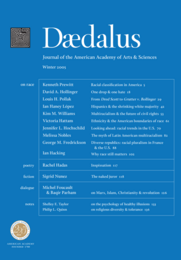Ethnicity & the boundaries of race: rereading Directive 15
Most of the racial and ethnic categories current in American life can be traced to an obscure government edict: Statistical Policy Directive No. 15, promulgated by the Office of Management and Budget (OMB) on May 12, 1977.1 Although the directive was officially limited to federal statistics and administrative reporting, its categories quickly became the de facto standard for American society at large, setting the terms ever since for racial and ethnic classification in the United States.
The OMB categories–specifically the Census Bureau’s use of them–are currently being renegotiated. Stripped of important particulars, the question on the table is whether Hispanics, to use the Census Bureau term, will continue to be classified as an ethnic group and not as a race. Ethnicity has long served to establish the boundaries of race by marking the dividing line between black and white. Where that line is drawn, who is designated as an ethnic, establishes the terms within which racial politics is waged in the United States.2
To comprehend the political choices at hand, we need to recover the somewhat arcane history of Directive 15. Retracing the OMB race categories is no simple antiquarian delight; it is required currency for following contemporary debates over racial classification and politics in the twenty-first-century United States.
Directive 15 was initially created as a means of standardizing the racial and ethnic categories used in government statistics. These data took on new political import after the passage of several civil rights laws. The Civil Rights Act of 1964, the Voting Rights Act of 1965, the Fair Housing Act of 1968, the Equal Credit Opportunity Act of 1974, the Home Mortgage Disclosure Act of 1975 –all required the federal government to monitor discrimination in a variety of policy domains. In order to assess discriminatory practices, agencies first had to specify the relevant protected groups, which in turn required stipulating racial and ethnic categories. Throughout the late 1960s and early 1970s, key civil rights bureaucracies established their own terms in order to comply with these new legislative mandates. This dispersed multiagency process of data collection proved unwieldy–hence federal government efforts to standardize the racial and ethnic categories via an interagency committee whose report the OMB codified in Statistical Policy Directive 15.3 . . .
Endnotes
- 1See “Directive No. 15, Race and Ethnic Standards for Federal Statistics and Administrative Reporting,” Federal Register 48 (87) (May 4, 1978): 19269–19270. The directive is accessible electronically as an appendix in “Standards for the Classification of Federal Data on Race and Ethnicity,” Federal Register 59 (June 9, 1994): 29834–29835. All citations to the directive will be to the 1994 reprint.
- 2I use the term ‘Hispanic’ throughout because this was the term initially adopted by the OMB. The OMB did not use the term ‘Latino’ until the 1997 revision of the directive.
- 3The federal interagency Committee on Education was established in June of 1974. The committee’s report, published in April of 1975, lays out almost all the features later promulgated by the OMB in Directive 15. For the directive’s history, see “Standards for the Classification of Federal Data on Race and Ethnicity,” 29831–29832; Barry Edmonston, Joshua Goldstein, and Juanita Tamayo Lott, eds., Spotlight on Heterogeneity: The Federal Standards for Racial and Ethnic Classification (Washington, D.C.: National Academy Press, 1996); Katherine K. Wallman, “Data on Race and Ethnicity: Revising the Federal Standard,” The American Statistician 52 (1) (February 1998): 31–33. For useful secondary sources on the directive, see Michael Omi, “Racial Identity and the State: The Dilemmas of Classification,” Law and Inequality: A Journal of Theory and Practice 25 (1) (1997): 7– 23; Margo J. Anderson and Stephen E. Fienberg, Who Counts? The Politics of Census-Taking in Contemporary America (New York: Russell Sage Foundation, 1999); David Hollinger, Postethnic America: Beyond Multiculturalism, postscript (New York: Basic Books, 2000); Melissa Nobles, Shades of Citizenship: Race and the Census in Modern Politics (Stanford, Calif.: Stanford University Press, 2000); Clara E. Rodriguez, Changing Race: Latinos, the Census, and the History of Ethnicity in the United States (New York: New York University Press, 2000); Peter Skerry, Counting on the Census: Race, Group Identity, and the Evasion of Politics (Washington, D.C.: Brookings Institution Press, 2000); Darryl Fears, “The Roots of ‘Hispanic’: 1975 Committee of Bureaucrats Produced Designation,” The Washington Post, October 15, 2003, A21.
